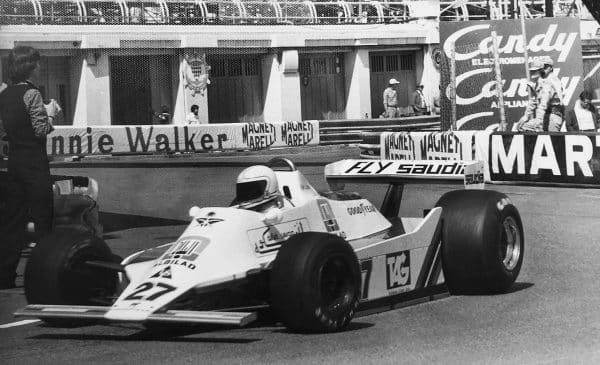In the more than four decades since its establishment in 1977, the Williams Formula 1 team has become one of the most successful and iconic participants in motorsport’s premier category. To date, Williams has claimed nine Constructors’ Championships and seven Drivers’ Championships, putting the British outfit second on the all-time list behind only Ferrari and followed closely by McLaren.
Remarkably, two of those seven drivers’ titles for Williams were won almost in consecutive seasons by two very different characters – the brash Australian Alan Jones in 1980 and the unflappable Finn Keke Rosberg in 1982. Despite their contrasting personalities off the track, Jones and Rosberg shared common traits that enabled them to achieve the pinnacle of success with the unfancied Williams team during an era of turmoil and transition for Formula 1.
Early Career Comparisons
While Jones and Rosberg took divergent paths to Formula 1, they both faced adversity early in their driving careers. Jones started in his native Australia racing a Mini and a Cooper.The younger Jones left for Europe in 1967, to make a name for himself, but found that he could not afford even a Formula Ford drive. He struggled to make an impression in lower formulae like Formula Atlantic and Formula 5000, earning a reputation as an aggressive driver who made mistakes.
Rosberg went from karting into Formula Vee and eventually Formula 2, but a combination of poor reliability and inconsistency meant he could never challenge the leaders, he managed to win three races between 1977 and 1979. His first years in Europe were spent transporting his own kart to races and living in the back of a transporter truck.
The determination of Jones and Rosberg saw them overcome their inauspicious starts to earn drives in Formula 1 – Jones debuted in 1975 with the small Hesketh team, while Rosberg finally entered the sport in 1978 with the Theodore Ford. But it took several further seasons of grafting before they got their big breaks with competitive race-winning machinery at Williams.
Both drivers were considered journeymen rather than future champions when they joined the team – their previous best championship finishes were 7th for Jones at Shadow in 1977 and 10th for Rosberg at Fittipaldi in 1980. However, Frank Williams saw their raw speed and matched it with strong cars – the ingredients for world championships.
Contrasting Characters
While they shared similar career arcs to reach the top in Formula 1, Jones and Rosberg’s personalities could hardly have been more different. The Australian had a larger-than-life personality which polarised opinion amongst fans and rivals. He was brash and headstrong, and tended to speak his mind bluntly rather than mince his words.
His driving style matched his personality – aggressive and forceful. Jones attacked every corner, hustling the car through on the very limit. When the car was to his liking, he was blisteringly quick. But when the setup wasn’t perfect, his maximum attack approach could lead to mistakes.
In contrast, Rosberg earned himself the nickname ‘Keke the sneaky Finn’. He was reserved and contemplative off the track, but remarkably calm and consistent behind the wheel. His adaptability was one of his greatest strengths – he could drive around problems with the car and maximise every opportunity. Rosberg also became known as a master in wet weather conditions.
The fiery Australian and the quiet Finn were therefore very different characters who approached racing in their own unique ways. However, their shared self-belief and inner determination enabled them both to ascend to the very top of Formula 1, despite widely contrasting personas.
Winning Ways at Williams
When driving for Frank Williams‘ team in the early 1980s, Jones and Rosberg showed they both had the ingredient that counts most in Formula 1 – sheer speed. The Williams cars of 1980 and 1982 were not the most technically advanced or refined, but their powerful Cosworth engines suited the aggressive driving styles of both drivers perfectly.
Jones claimed Williams’ first Drivers’ Championship in 1980 with five wins alongside Carlos Reutemann. The Australian won the United States Grand Prix West in dominant fashion, leading all but one lap to beat Reutemann by a lap. Further victories in Argentina, France, Britain and Canada sealed the title.
Rosberg’s championship campaign followed just two years later in 1982. The Finn’s season got off not very well with only a couple of second places in USA and Belgium…. Just a single win in Switzerland followed, but Rosberg kept accumulating points thanks to the reliability and fuel economy of the Williams. He clinched the title with a fifth place in the final round in Las Vegas. Consistency, not raw speed, took Rosberg to a surprise world championship.
So while Jones overwhelmed his rivals with his sheer pace over a single season, Rosberg’s title was reward for an unflappable determination to keep racking up points however he could. Different approaches, but both extremely effective in eventually delivering the drivers’ crown.
Life Outside Formula 1
As well as their driving exploits on track, both Jones and Rosberg cultivated celebrity profiles through their interests and activities outside of Formula 1. The Australian built a playboy image, dating models and socialising in the European party scene during his F1 career.
Jones also pursued his passion for aviation, obtaining his pilot’s licence and even competing in air races. He formed a stunt flying team called ‘The Humming Birds’ that performed across Australia. The hands-on danger of aerobatic flying appealed to his need for action and adrenaline.
In contrast, Rosberg prided himself on his business acumen and entrepreneurial spirit. He founded companies like a talent agency for Finnish athletes during his own career. Rosberg always had an eye on building a career and profile after Formula 1.
Both drivers were therefore multi-dimensional characters who achieved success on the track but also developed their interests and passions off it too. Jones built a thrill-seeking playboy image, while Rosberg’s intellect saw him establish business credentials.
Life After F1
When their driving days ended, Jones and Rosberg took very different career paths. The Australian returned home to pursue his love of flying, becoming a renowned air show pilot. He also built a successful commentary career working for Australian TV coverage of Formula 1, endearing himself to viewers with his forthright opinions.
Rosberg went down the team ownership route by establishing his own squad, Team Rosberg, to race sportscars. The team progressed to the DTM German touring cars and his son Nico – himself a future F1 champion – drove for the team in F3 in 2003 and 2004. Keke also held ambassadorial roles for Williams and Mercedes after retiring.
Both world champions therefore forged successful second careers that allowed them to stay involved in racing on their own terms. Jones built his profile as a media personality through broadcasting, whereas Rosberg’s analytical approach saw him guide his own team and son towards the top.
Lasting Legacies
The championship-winning seasons of Jones and Rosberg with Williams both represented watershed moments in the history of Formula 1. Jones’ 1980 title was the first for Williams, proving that an upstart independent team could overcome the might of traditional powerhouses like Ferrari and Lotus.
Rosberg’s 1982 triumph came amidst a backdrop of political turmoil, as the FISA-FOCA war threatened to tear Formula 1 apart. His against-the-odds championship provided hope for smaller teams striving for success against the manufacturer outfits.
Jones and Rosberg also disproved the theory that you needed to be born in a traditional racing nation to win in F1. An Australian and a Finn conquering the pinnacle of motorsport opened the door for future champions from new horizons like Central and South America.
So the supreme talents of Alan Jones and Keke Rosberg, paired with the engineering ingenuity of the Williams team, made them pioneers for Formula 1’s future. Their championships proved that you didn’t need the biggest budgets or best pedigree to reach the very top.
Final Summary
Williams struck World Championship gold in 1980 and 1982 with two very different personalities in Alan Jones and Keke Rosberg. The brash Australian and the unflappable Finn took contrasting approaches on track, but shared the determination and self-belief required to achieve the ultimate prize.
Both men overcame difficult starts in lower formulae through their natural talent and grafting spirit. Their aggression and consistency respectively found the perfect outlet in the Cosworth-powered Williams cars of their title-winning seasons.
Passions like aviation for Jones and business for Rosberg saw the pair develop wider profiles away from the track. And in retirement, broadcasting and team ownership allowed them to continue their association with the sport they graced.
With their historic title wins, Jones and Rosberg opened Formula 1’s door to the future. They proved that drivers from any background could reach the pinnacle, and that small independent teams could overcome larger outfits. That pioneering legacy means the Australian and the Finn will forever remain two of Williams’ greatest champions.

















